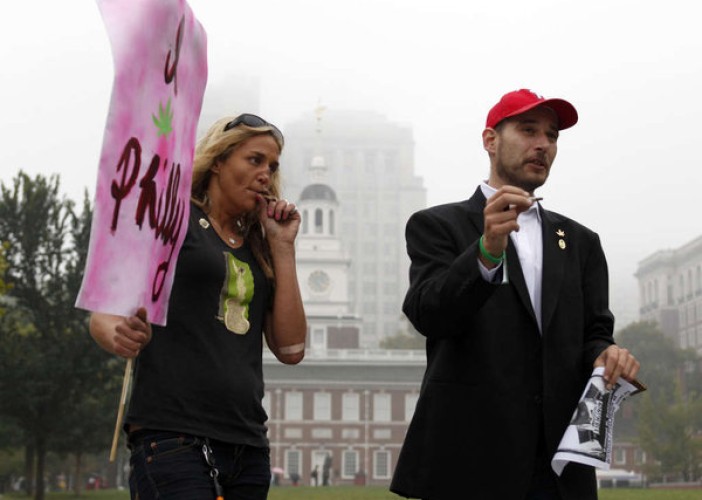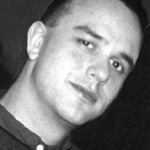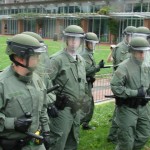
by Chris Goldstein – In the fall of 1994 I walked up Pine Street on one of those clear autumn days that make living in Philly a joy. The smell of the gigantic apple pies baking at More Than Just Ice Cream filled the air. The tall trees lining the street were just beginning to release their blood orange, brown and maroon leaves to crunch underfoot on the sidewalk. The afternoon sunlight beamed down, warm and gold, between the old fashioned brick buildings and antique shops.
My friend, Patrick Kirk, reached into his pocket and pulled out a plump marijuana joint.
We were both freshmen in the acting program at University of the Arts. I was an idealistic 18 year old kid, fresh out of a suburban high school and living in the city for the first time. Kirk was in his mid-twenties and a longtime, street-smart urbanite.
We arrived at the corner of 11th and Pine in a pretty space called Louis I. Khan park. It is small, just a triangle of the corner, but meticulously landscaped with a fountain along the back wall and comfortable wooden benches throughout.
Kirk lit the joint. At first I was nervous about smoking so openly. But Kirk reassured me, saying something to the effect of; “It’s not a big deal.”
We passed it back and forth, laughing about our stage combat class with our fierce fake punches and shoulder rolls across the stage earlier in the day. Plenty of people smelled our sweet cloud. Some smiled, others sneered. No one stopped. No one called the police. We were not arrested. Me and Kirk; both white.
Thus began my two-decade long journey of casually smoking marijuana in public. City police here in Philly or Austin, TX, Santa Fe, NM, Denver, CO, San Francisco, CA, Los Angles, CA, Nashville, TN, New York, NY, Boston, MA, Portland, ME, Tampa, FL and dozens of other towns never arrested me for marijuana. Ever. Probably because I am white.
Stats and the Streets
Last week I posted a column at philly.com about the marijuana arrest statistics in Philadelphia. Like most cities in America, a disproportionate number of those arrested for possession (83.3%) are African American. Usually I don’t read the comments on my articles. But several readers also sent me some email about the piece, so I scrolled through the comment section.
There seemed to be a common thread of serious misconceptions. None of them jibe with the real world.
1) White people always smoke marijuana discretely and indoors while African Americans always brazenly smoke on the street
2) African Americans are caught during other crimes and also have marijuana
3) All cannabis consumers are scofflaws
On the first point I can only shake my head and laugh. Apparently some folks have never seen a Grateful Dead, Phish, Rolling Stones, Cypress Hill, Willie Nelson or Dave Matthews concert outdoors in Philly. These same cloistered observers perhaps have never strolled through the tailgate parties in the parking lots at Phillies, Eagles or Penn State games or even attended a single Mummers Parade. All of the aforementioned gatherings feature tens of thousands of white people, from 18 to 80 years old, smoking marijuana essentially in public. Even on an average summer night on South Street or Society Hill it is ubiquitous. All of those events and venues also have a healthy contingent of police.
On the second point I can see how casual observers of the crime data might think that numbers could be mixed up a bit. But a vital fact about the Pennsylvania Uniform Crime Reporting System: It has a hierarchy logarithm. That means someone caught committing a more serious crime while in possession of marijuana does not show up in the final tally of pot arrests. Example: A person caught with a gun and some weed is listed as a firearms arrest and not a marijuana arrest. So the 4,336 cannabis arrests in 2013 were essentially stand-alone offenses.
The third point is completely unfounded. Cannabis consumers of all colors come from all walks of life. These are our friends, neighbors and family members. Those who enjoy smoking, vaporizing or eating cannabis are retail workers, restaurant employees, writers, photographers, government employees, lawyers, accountants and likely even many members of law enforcement. Marijuana is in all classes, all neighborhoods and all ethnic groups. It is part of the fabric of this city and the United States as a whole. Consumers are otherwise law abiding citizens.
Another misconception is that everyone in Philly is just smoking for recreation. Medical marijuana is not legal in Pennsylvania…yet. It is unknown how many of those arrested for possession or cultivation are doing so to treat a condition that one day soon could qualify for regulated access. Cannabis is beneficial for HIV, cancer, sickle cell anemia, lupus, multiple sclerosis, PTSD and dozens of other conditions.
Right now police do not ask if a person has a disease or ailment, they just bust people with weed. The reality is that many residents are fully aware of the medical benefits of cannabis and the laws allowing it in other states. But every ill Pennsylvania resident is forced to purchase it in the underground market until Harrisburg passes legislation.
Again, for most of my adult life I had been casual about consuming cannabis. It was not until I took up smoking joints in public as a form of planned civil disobedience that I was cited and brought into the criminal justice system. But I had to really try.
The first time was in October 2012. Colleen Begley and I went out to Independence Hall National Historic Park, held some signs and lit a joint to remember the first people busted for federal marijuana prohibition seventy-five years before. We were not detained or cited or even approached by park rangers.
Then we held the Smoke Down Prohibition protests at the same location from December 2012 to December 2013. Hundreds of people joined us in civil disobedience.
For the first four months there were no arrests or citations. But in May of 2013 a massive police operation was launched against us. More than one hundred National Park Service Rangers (some in green riot gear), Philly Police, SEPTA Transit Police and Department of Homeland Security agents descended upon our peaceful group. The US Attorney set up a processing tent and handed out federal citations for marijuana possession. I was cited for the first time in June.
But the strangest protest was in July. I smoked an entire joint with that army of police keenly looking on. They cited several people around me but, oddly, left me alone.
For a minute I thought my black Calvin Klein suit was a force field. But then I got a second citation in August. The federal prosecutor took me to trial. I was sentenced in March 2014 to two years of supervised probation and a $3,000 fine. The heavy sentence for possessing 0.4 grams of cannabis was perhaps seen as the only way to stop Americans from publicly smoking marijuana as an open protest. But for twenty years the Seattle Hemp Fest and the Boston Freedom Rally have hosted tens of thousands of people doing just that.
I completely stopped consuming in February. It was easy. Don’t take away my morning coffee though. Since then I have redoubled my efforts to change these unjust laws. I’m also planning a long vacation to Denver in 2016.
The Big Green Picture
In a previous column I pointed out that the prohibition of cannabis had a racist intent since the 1930’s. It carried over to 1970 when President Nixon crafted the Controlled Substances Act.
The events in Ferguson, Missouri after police shot unarmed Michael Brown have inspired a new and vigorous conversation throughout the country. The key points are the militarization of police and the relationship between law enforcement and communities of color. What Nixon called the “War on Drugs” has been central to many of the problems that urgently need solutions.
An interesting point: The SWAT Team actually originated as a Philadelphia Police Department program in 1964 and then spread to urban departments around the country in the 70’s and 80’s. Now they are common in departments even in the smallest of American towns. The ACLU released a report showing that more than 62 percent of SWAT deployments were to execute search warrants over drugs.
This massive use of force in the name of marijuana prohibition all to often ends in tragedy.
A recent case in Tampa, FL highlighted the issue. Jason Westcott had called police in fear of his life after someone threatened to rob and kill him. He was told to use his firearm if anyone tried breaking into his home. But something else was happening. After a police informant purchased $160 worth of marijuana over a four month period a SWAT Team was raided his house in the early morning of May 29, 2014. Westcott, 29, was immediately shot to death when they entered his bedroom and found him crouching with his gun. They found $2 worth of marijuana in the apartment after the raid. His family and neighbors scoffed at the idea that Westcott was a big time dealer. The officers were cleared of any wrongdoing in his killing.
Here in Philadelphia this June there was a disturbing incident involving the notorious Police Narcotics Unit. Sean Broaddus was followed into a corner sore by several narcotics officers who suspected him of selling small amounts of marijuana. After a brief struggle witnesses said Broaddus was put into a choke hold. Seconds later he was dead. His wife, Margo, was watching the entire incident. Police found no marijuana and just $12.90 in his pockets.
The war that Richard Nixon created is not on drugs but on people.
Marijuana prohibition enforcement is institutional racism. It is enforced at gunpoint. That is the uncomfortable reality. The arrest statistics show that in the hard numbers year after year.
Prohibition has created the environment for police abuses and corruption. It has also, arguably, been the cause of the biggest strain between police departments and the communities they are meant to protect. Yet, prohibition may be of the easiest and most logical institutions to change.
Public marijuana smoking remains against the law, even in the two legal states. It is a discrimination that cannabis consumers endure as Americans gleefully smoke tobacco or drink alcohol at street cafes or in stadiums.
There is another hypothesis I would like to offer as to why so few white people are arrested in Philly for marijuana: Police simply let them go. There are no statistics or official data that I can use to demonstrate this fact, just dozens and dozens of anecdotal reports from white consumers over the years. White people do get arrested, there is not ethnic immunity. But there is no reason that it should happen so few and far between in Philly.
Sure, there are strong economic benefits to such comprehensive reform: Millions of dollars gained in taxes and billions saved on public safety.
But there are also benefits that are truly priceless, like a measured victory in racial equality and some peace on the streets.
2 Responses to "Misconceptions of marijuana in Philly"
Comments are closed.



Chris you’ve become the greatest black marijuana activist in philly – kind of clintonesc
Hi Chris, Imagine my surprise when I came across my photo of Patrick in your post. (It was taken by our friend, I am the person, cut out, in the photo with Patrick) Not at all sure how I feel about that, you posting about Patrick after he is gone so of course without his permission, and using a personal photo of mine too. I wont comment on whether or not Patrick would have supported your posting because really that isn’t the issue here… I would appreciate hearing back, I will check back here tomorrow, thanks Chris… Kate